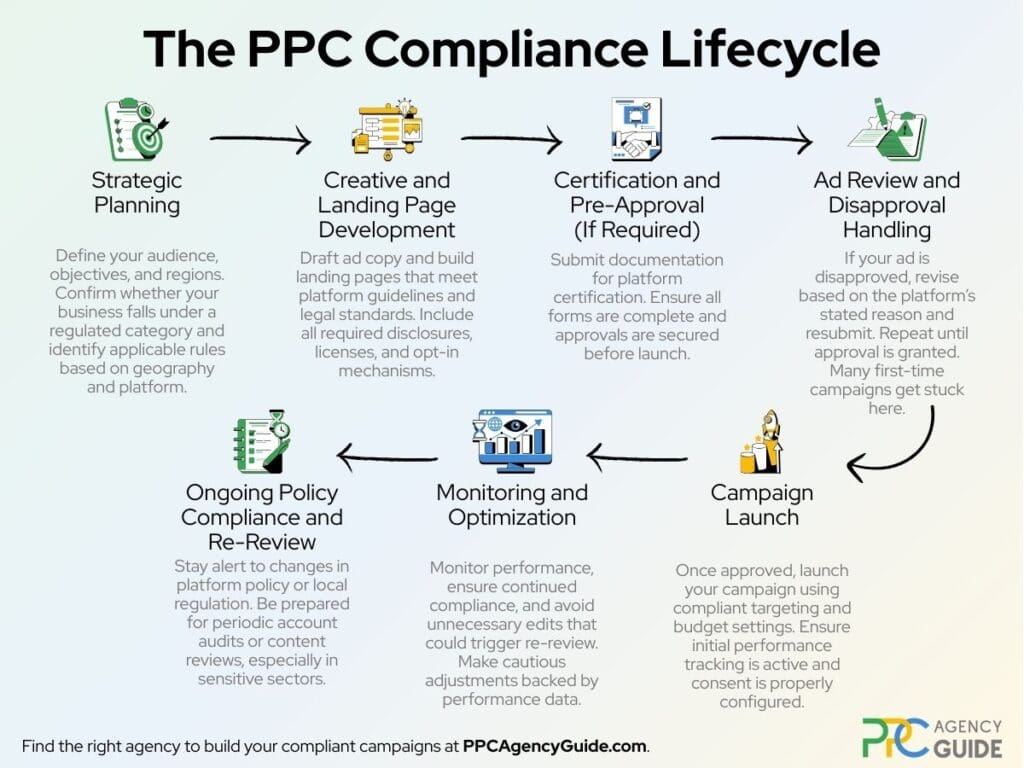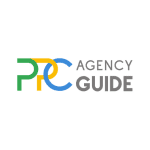
Do you oversee marketing or advertising for a business that changes lives? Being on the frontlines of that, whether you’re connecting people to products and services that can transform their health, improve financial security, or even keep them out of hot water with the law, is often emotionally rewarding for business leaders and marketers. But, because what you do deeply impacts people, those managing pay-per-click (PPC) for regulated industries are held to much higher standards than others.
In this guide, we’ll walk you through some of the organizations that regulate how brands can present themselves and their offerings, common guidelines you’ll need to meet, and best practices for running ethical, compliant ad campaigns.
Applying the PPC compliance strategies we share below will help ensure you follow local regulations, streamline your ad approvals on various platforms, and build better relationships with your audience through honest and transparent campaigns, all without harming ad performance. However, it is not a substitute for obtaining timely professional advice that’s tailored to your business and the jurisdictions you operate in. Because of this, we recommend connecting with a PPC agency that’s equipped to assist and offer personalized insights. Request a free consultation to begin the matching process.
What Counts as a Highly Regulated Industry in PPC
When you hear the term “highly regulated industries” in digital advertising, it refers to sectors where government agencies and advertising platforms impose strict controls on how businesses can promote their products or services.
It can also be referred to as the “Your Money or Your Life” (YMYL) category, as coined by Google. It’s a broad category of content that essentially encompasses anything that has the potential to impact a person’s happiness, health, financial stability, or safety. The term “YMYL” is often used in association with search engine optimization (SEO), but the core concepts apply to advertising as well.
The rules relating to it vary by platform and region, but the goal is consistent: to protect consumers from misleading, inappropriate, or harmful advertising.
Common Industries Subject to Heavy Regulation
Industry-specific PPC strategies are necessary if your business or offerings fall into one of the categories outlined below.
- Healthcare and Medical Services: The healthcare category includes businesses that promote pharmaceuticals, medical devices, supplements, clinics, and therapy services. These businesses must comply with strict health claims regulations and patient privacy standards.
- Health and Wellness Products: This covers businesses promoting supplements, diet plans, fitness programs, or alternative therapies. Many claims in this space require substantiation to avoid violations, even if over-the-counter.
- Financial Products and Services: The finance category includes lenders, investment firms, insurance providers, and credit counseling services. Regulations in this sector aim to protect consumers from deceptive claims and ensure transparent disclosures.
- Legal and Claims-Based Services: Legal PPC campaigns naturally encompass law firms and services that handle personal injury, workers’ compensation, or legal representation. Advertising in this space is often governed by professional conduct standards and rules about solicitation.
- Educational and Certification Programs: This category includes schools, certification providers, and online course platforms. Businesses must follow advertising rules designed to prevent misleading claims about outcomes or accreditation.
Note that this is not a comprehensive list. If your business can impact a person’s happiness, health, financial stability, or safety, it fits into the YMYL category and is likely subject to regulated industry PPC guidelines.
Familiarize Yourself with Key Regulatory Bodies by Region
You need to follow the regulations in the location where your business operates and in every region where your ads are shown. This often means meeting legal requirements at the national level, complying with rules set by provincial or state authorities, and aligning with advertising platform policies. Each layer plays a role in how your campaigns are reviewed and approved.

You need to follow the regulations in the location where your business operates and in every region where your ads are shown. This often means meeting legal requirements at the national level, complying with rules set by provincial or state authorities, and aligning with advertising platform policies. Each layer plays a role in how your campaigns are reviewed and approved.
United States
- Federal Trade Commission (FTC): The FTC regulates advertising practices to ensure that claims are truthful, not misleading, and backed by reliable evidence.
- Food and Drug Administration (FDA): The FDA oversees the promotion of prescription drugs, medical devices, and certain supplements to ensure compliance with health and safety standards.
- Consumer Financial Protection Bureau (CFPB): The CFPB enforces transparency requirements in financial advertising and works to prevent deceptive practices in lending and credit services.
- State-Level Licensing Boards: These boards regulate professional advertising in fields such as law and medicine and may impose additional restrictions beyond federal standards.
Canada
- Competition Bureau: The Competition Bureau monitors all industries for false or misleading advertising and enforces penalties for deceptive marketing tactics.
- Health Canada: Health product advertising, such as pharmaceuticals and natural health products, is regulated by Health Canada to ensure consumer safety.
- Financial Consumer Agency of Canada (FCAC): The FCAC ensures that financial institutions follow national marketing standards and provide accurate, easy-to-understand information.
- Provincial Regulators: These regulators enforce region-specific rules, especially in sectors such as healthcare, insurance, and cannabis.
United Kingdom
- Advertising Standards Authority (ASA): The ASA enforces the CAP Code and investigates complaints related to misleading, harmful, or irresponsible advertising.
- Financial Conduct Authority (FCA): The FCA regulates advertising in the financial sector, including investments, pensions, and insurance products.
- Medicines and Healthcare Products Regulatory Agency (MHRA): The MHRA ensures that advertisements for medicines and medical devices comply with health and safety laws.
- Information Commissioner’s Office (ICO): The ICO enforces privacy regulations and ensures that digital advertisers comply with laws governing personal data and tracking.
Be Aware of Platform Policies That Layer Additional Constraints
Even if your campaigns comply with all local and national regulations, advertising platforms still apply their own set of rules. These platform policies often mirror government regulations but tend to be broader, more restrictive, and subject to sudden changes. You’re expected to follow both sets of requirements.
Each advertising platform has its own approval process and may block ads that mention sensitive topics, use certain targeting methods, or promote regulated services, even if everything is legally compliant. If your business operates in a highly regulated industry, you’ll want to be familiar with these standards before launching a campaign.
Google Ads
The Google Ads platform restricts or disapproves of ads related to credit repair, addiction treatment, and certain types of medical procedures. It also limits targeting methods such as remarketing in sensitive categories and often requires certification to advertise in regulated sectors. The Microsoft Advertising platform has similar guidelines.
Meta (Facebook and Instagram)
Meta requires pre-approval and account-level authorization for ads related to social issues, health, finance, and politics. Ads on Facebook and Instagram must include disclaimers, and targeting may be restricted based on user age, location, or interests.
LinkedIn closely reviews ads that reference employment status, personal characteristics, or financial conditions. Even compliant content can be flagged if it appears to violate professional guidelines or LinkedIn’s platform expectations.
Leverage Targeting Strategies That Comply Without Killing Reach
Targeting is one of the first areas restricted by both regulators and ad platforms. In regulated industries, you cannot always use the same demographic, behavioral, or interest-based filters available to general advertisers. That doesn’t mean your reach has to suffer; your strategy needs to adapt.

Know What Targeting Strategies Are Off Limits
Before launching any campaign, review the platform’s policies for restricted categories. Common limitations include:
- Restricted Use of Personal Attributes: Platforms often prohibit targeting based on personal characteristics such as medical conditions, financial hardship, or legal history.
- Limited Retargeting in Sensitive Sectors: You may not be allowed to serve follow-up ads to users who visit pages related to topics like addiction treatment, mental health, or credit services.
- Age and Location Restrictions: Some industries require you to include minimum age filters or exclude regions where the product or service is not approved or licensed.
Apply Targeting Best Practices for Sensitive Industries
You can still create targeted campaigns that reach the right audience while managing PPC compliance. The key to effective PPC in strict industries is to focus on context, intent, and qualification.
- Use Contextual Targeting Instead of Personal Profiles: If you cannot target based on interests or demographics, focus on where your ads appear. Target content categories or keywords that signal relevant context, such as industry news, educational content, or problem-solving searches.
- Refine Geographic Targeting Thoughtfully: Use location filters to include regions where your service is approved and regulated and exclude areas that could trigger problems with ad compliance for PPC.
- Incorporate First-Party Data Carefully: If you’ve collected data from users who have opted in, you may be able to build custom audiences for remarketing. Just make sure your consent practices are clear and legally valid.
- Leverage Professional or Industry-Based Targeting: On platforms like LinkedIn, targeting by job title, industry, or company size is often allowed and effective for B2B campaigns.
- Use Broad Match with Qualification in the Ad Copy: If your targeting must remain wide due to restrictions, tighten your funnel with clear messaging that qualifies leads before they click.
What to Avoid While Applying Targeting Best Practices for Sensitive Industries
- Over-Segmenting the Audience: Adding multiple filters may seem safer, but it can lead to ad disapproval or underdelivery.
- Assuming Platform Approval Equals Compliance: Just because an ad runs does not mean it meets regulatory requirements. Make sure your targeting decisions hold up under legal scrutiny.
Create Effective Ad Copy without Triggering Rejections
Disapproval of copy is one of the most common ad policy challenges. Even if your service is legitimate and your offer is clear, the language you use must align with both legal standards and platform-specific rules. That includes what you say, how you say it, and sometimes, even what you leave out.

Understand What Triggers a PPC Ad Copy Compliance Review
Advertising platforms use a mix of automation and human review to scan ads for compliance issues. In regulated categories, that scrutiny increases. Common triggers include:
- Claims That Require Evidence: Phrases like “guaranteed results” or “cure your anxiety” can get flagged unless they are backed by approved studies or certifications.
- References to Personal Attributes: Language that suggests someone has a medical condition, financial problem, or legal issue can violate platform rules, even if your intent is helpful.
- Omissions That Create Misleading Impressions: Ads that gloss over eligibility requirements or legal limitations can be rejected, even if the details are on the landing page.
Apply Best Practices for Crafting Compliant PPC Ads
Your ad copy needs to be accurate, transparent, and aligned with platform policies. This often requires more precise wording than general marketing campaigns.
- Use Clear, Fact-Based Language: Focus on what your service does, not what it promises. Say “Supports joint comfort” instead of “Eliminates joint pain.”
- Qualify Your Offer in the Ad: If your service is only available in certain regions or to specific groups, make that clear before the click. This reduces ad disapprovals and improves lead quality.
- Mirror Platform and Industry Language: Review how your competitors in the same space phrase their ads. If they’ve been approved, use their language as a model while staying true to your brand.
- Avoid Sensational or Emotional Phrasing: Words like “finally,” “life-changing,” or “instantly” may sound persuasive but can lead to flags in healthcare or financial categories.
- Ensure Consistency with the Landing Page: Ad copy and landing page messaging must align. If there’s a disconnect, the platform may reject your ad for lack of transparency.
Consider Using Dynamic or Modular Copy
If you advertise across multiple regions with different restrictions, modular ad copy can help:
- Use Location-Based Variations: Customize lines based on local rules, especially for regulated terms.
- Create Tiered Copy: Develop “safe,” “moderate,” and “aggressive” versions, and rotate based on platform response and performance.
Know What Review Teams Actually Look for in Landing Page Compliance
Even if your ad passes review, your landing page can cause the entire campaign to be disapproved or your account to be flagged. In regulated industries, platforms also evaluate where the ad sends people and whether the experience aligns with policies and legal requirements.

Why Landing Pages Are Heavily Scrutinized
Advertising platforms are liable for what users see when they click on ads. To reduce risk, they review landing pages for:
- Accuracy and Transparency: The page must deliver what the ad promises without burying important limitations or conditions.
- Legal and Regulatory Disclosures: Some industries require specific language, disclaimers, or licensing information to be present and clearly visible.
- User Safety and Experience: Pages must load quickly, work on mobile devices, and avoid tactics that are considered deceptive or confusing.
What Your Landing Page Should Include
If you’re operating in a regulated industry, your landing page needs to validate the credibility and legality of your offer.
- Clear Identification of Your Business: Include your business name, contact information, and links to privacy policies and terms of service. This builds trust and satisfies most platform transparency requirements.
- Licensing and Disclosures: If your industry requires certification, registration, or legal disclaimers, those must appear on the page. This includes things like attorney licensing info, clinic certifications, or lender disclosures.
- Accurate, Verifiable Claims: Any benefit or outcome you mention must be something you can legally and factually back up. Broad or emotional claims without substantiation increase the risk of rejection.
- No Bait-and-Switch Language: The content and tone of your landing page should match what the user expected when clicking the ad. If the ad implies a consultation and the landing page pushes a purchase, that misalignment can result in disapproval.
- Visible Opt-In and Consent Mechanisms: If you’re collecting data, especially in sensitive categories, users must clearly see how their information will be used. Cookie notices and form disclaimers should be in place.
What to Avoid on Landing Pages When Leveraging PPC for Strict Industries
- Hard-to-Find Legal Copy: Putting required disclosures in tiny footers or hidden behind links does not meet most platform standards.
- Excessive Pop-Ups or Redirects: These are viewed as manipulative and are flagged more aggressively in regulated industries.
- Omissions That Undermine Trust: If a competitor is clearly listing certifications, pricing terms, or eligibility criteria, and your page avoids them, your ad may not survive the review process.
Be Ready for Platform Certification and Pre-Approval Processes
In many regulated industries, you can’t run ads until the platform explicitly approves your business or campaign. This isn’t a one-time checkbox. Certification processes can be lengthy, and pre-approvals often involve uploading documentation, disclosing licensing information, or submitting sample creative for manual review. If you skip this step, your ads won’t run, no matter how compliant they appear.

When Certification or Pre-Approval is Required
Certification requirements vary by platform and industry. In some cases, it’s mandatory at the advertiser level. In others, it applies to specific types of ads.
- Healthcare and Medicine: Platforms like Google require advertisers promoting prescription drugs or addiction treatment to complete a healthcare-specific certification process.
- Financial Services: Businesses offering credit repair, personal loans, debt consolidation, or investment products must complete platform certification and follow additional content policies.
- Social Issues and Political Ads: Meta and LinkedIn require identity verification and disclaimers before running any ads related to government, policy, or social causes, even for private businesses operating in those spaces.
- Employment and Housing-Related Ads: Ads promoting job opportunities, real estate, or related services must follow audience targeting restrictions and, in some regions, go through additional review.
What the Process Usually Involves
While each platform has its own system, most follow a similar pattern:
- Identity Verification: You’ll be asked to verify your business identity using legal documentation or official contact details.
- License or Accreditation Submission: For industries like law, medicine, and finance, you may need to submit proof of licensing or registration with a regulatory body.
- Disclosure Agreement: Some platforms require that you agree to specific terms for advertising in a sensitive category, including ongoing compliance monitoring.
- Manual Creative Review: If your category is under close watch, your ad creative and landing page may go through a manual approval process before anything goes live.
Examples of Platform-Specific Programs
- Google’s Healthcare and Medicines Policy: Addiction treatment ads cannot run without LegitScript certification and additional authorization for prescription drug advertising
- Meta’s Ads About Social Issues, Elections, or Politics: ID verification and clear disclaimers are required on each ad, even if the content is nonpartisan or educational.
- LinkedIn’s Financial Services Advertising Rules: Restrictions on how investment opportunities and financial guarantees can be presented are set, often requiring additional account vetting.
What to Expect After Ad Approval in Regulated Industries
Approval does not guarantee long-term access. Most platforms retain the right to re-review your account, especially if user complaints arise or policy updates occur.
- Ongoing Monitoring: Your account may be flagged for review if you change your offer, update your targeting, or increase your budget.
- Limited Editing Flexibility: Once an ad is approved in a sensitive category, even small changes can trigger a re-review process.
- Higher Standards for Appeal: If your ad is disapproved after being approved previously, platforms may require additional documentation to reinstate it.
Be Proactive When Your Ads Get Flagged or Disapproved
In regulated industries, disapprovals are not always a sign that you did something wrong. Sometimes, your ad gets flagged because a reviewer doesn’t understand the nuance of your offer. Other times, automated systems misread phrasing or context. Regardless of the cause, how you respond can determine whether the issue gets resolved quickly or escalates into something bigger.

Understand Why the Ad was Flagged
Start by reviewing the reason listed in your platform’s disapproval notice. The language may be vague, but the category can point you in the right direction.
- Policy Violation: This often relates to restricted content, unsupported claims, or targeting that doesn’t meet platform standards.
- Editorial Issue: These are usually easier to fix and involve formatting, punctuation, or capitalization problems.
- Destination Mismatch: This means your ad and landing page do not align in message or content.
- Account-Level Violation: If flagged, this may indicate repeated disapprovals or a serious violation that puts the account at risk.
Steps to Take Immediately
Your first move should be to assess whether the disapproval is accurate, and if not, prepare to escalate it.
- Check for Obvious Fixes: Review your ad and landing page for any language that could be misinterpreted. Simplify claims, remove superlatives, and double-check disclosures.
- Compare Against Platform Policy: Read the specific policy cited in the disapproval. Most platforms provide examples and definitions that can help you rework your copy or settings.
- Make a Clean Revision: If you believe the ad was borderline but fixable, revise and resubmit. Make one clear change rather than multiple adjustments that might trigger a second disapproval.
- Request a Review if You’re in Compliance: If you believe the disapproval is incorrect, use the appeal or review process to explain your case. Keep your tone factual, cite platform policies directly, and highlight how your ad meets the listed requirements.
When to Escalate
Sometimes, a basic review request isn’t enough, especially if the issue repeats or affects your account standing.
- Use a Verified Agency or Partner Manager: If you work with an agency or have a partner manager, escalate the issue through them. They often have access to support tiers that aren’t available to individual advertisers. If you need help finding one, connect with us.
- Document the Pattern: If ads are repeatedly flagged despite compliance, keep a log of disapprovals, revisions, and outcomes. This documentation can support your case if you need to escalate to a higher support level.
- Consider a Backup Campaign: If timing is critical, consider running a version of your campaign with alternate language or creative while you wait for resolution.
Prevent Future Disruptions
- Stay Up to Date on Policy Changes: Platform rules in regulated industries evolve frequently. Subscribe to policy updates or check help center pages before launching new campaigns.
- Limit Frequent Edits: Constantly adjusting copy or targeting in regulated accounts increases the chances of triggering a review. Finalize campaigns before publishing when possible.
- Use Labels and Notes Internally: Keep track of which ads have been approved with which copy and targeting. This helps avoid accidentally reintroducing previously flagged elements.
Adjust Tracking and Reporting for Sensitive Categories
Tracking is one of the most valuable parts of PPC, but in regulated industries, it can also be one of the most restricted. Privacy laws, platform limitations, and ethical considerations all shape what kind of data you’re allowed to collect and how you’re allowed to use it.
This doesn’t mean performance measurement is off the table. It means you need to approach it with precision, transparency, and a clear understanding of what the law and the platform will allow.
Understand the Legal Environment
If your business operates in a regulated category, you may be required to comply with one or more data privacy laws:
- General Data Protection Regulation (GDPR): Any business that targets users in the United Kingdom or European Union is subject to GDPR. It governs how personal data is collected, stored, and used.
- California Consumer Privacy Act (CCPA): Businesses that collect personal data from California residents are subject to the CCPA. It includes requirements around opt-outs and data access.
- Health Insurance Portability and Accountability Act (HIPAA): Businesses in the healthcare space in the United States must follow HIPAA guidelines, which limit how user health data can be tracked or shared.
- Canada’s Personal Information Protection and Electronic Documents Act (PIPEDA): How Canadian businesses handle personal information in digital marketing is addressed through PIPEDA.
Use PPC Compliance Tools That Prioritize Consent and Privacy
If you’re working in a sensitive category, tracking strategies need to shift away from aggressive remarketing and behavioral tracking. Instead, focus on regulated PPC management tools and techniques that respect privacy without sacrificing insight.
- First-Party Analytics Platforms: Consider using platforms like Matomo or server-side Google Analytics to collect data you control while respecting privacy laws.
- Consent Management Platforms (CMPs): Use compliance-focused PPC tools that allow users to opt in to tracking. Make sure they are configured correctly and reflect the latest legal requirements in each region.
- Event Tracking Instead of User Profiling: Track actions like form submissions, calls, or downloads rather than trying to build detailed user profiles.
Focus on Reporting That Aligns with Platform Rules
Platform-reported data will often look different in regulated campaigns, especially when audience visibility is limited.
- Expect Lower Visibility into Demographics: Many platforms will suppress demographic reporting in categories related to health, finance, or legal issues.
- Use Conversion Tracking That Respects Consent: Set up conversion goals that trigger only after users engage voluntarily, such as submitting a form or clicking a tracked phone number.
- Avoid Using Data to Build Lookalike or Retargeting Audiences without Consent: In most regulated industries, this type of profiling requires explicit permission and often falls outside what platform policies allow.
Prepare for Gaps and Offset Them with Strategy
Even when fully compliant, tracking in regulated industries will likely feel incomplete. The solution is not to collect more data, but to make better decisions with the data you do have.
- Segment by Campaign Type and Landing Page: Grouping results by content or intent can reveal performance patterns without requiring personal tracking.
- Pair Quantitative and Qualitative Feedback: Use call recordings, form responses, or CRM notes to supplement limited ad data with real customer insight.
- Set Internal Benchmarks by Funnel Stage: Track early indicators like click-through rate, time on page, or lead qualification to help diagnose where improvements are needed.

Work with Someone Experienced in Managing PPC for Regulated Industries
While this guide can help you develop PPC strategies for compliance, there are a lot of nuances related to your offerings, location, and platforms that impact success and compliance. If you don’t already have a professional on your team who understands these nuances, an experienced PPC agency is invaluable.
This is where PPC Agency Guide comes in. We’ll meet with you for a virtual consult, where we get to know your business, your goals, and the specific challenges of regulated PPC you’re facing. From there, we’ll match you with PPC experts for regulated industries that have the expertise you need and a track record of strong results, all at no cost to you. To take the first step, request your consultation.
FAQs on PPC for Regulated Industries
What are some tips for balancing PPC spend and compliance?
Use ad spend strategies that focus on high-intent, low-risk audiences. Limit targeting to approved regions, build clear funnel stages, and avoid wasting budget on segments likely to trigger disapprovals. Conservative test budgets paired with strong first-party data can help you optimize without overexposure to compliance risks.
Who performs PPC audits for regulated PPC campaigns?
PPC audits for compliance are typically handled by specialized PPC agencies or internal marketing teams with regulatory experience. These audits review your targeting, ad copy, landing pages, and tracking setup to ensure all elements follow platform policies and industry-specific advertising laws.
What are some PPC keyword strategies for regulated sectors?
Focus on intent-driven, informational, and service-related keywords rather than emotional or results-based terms. Avoid language that implies guarantees or diagnoses. Use negative keywords to filter out unqualified traffic and test variants that stay within platform policy guidelines while still reaching your ideal audience.
What’s the fastest way to go about optimizing PPC for compliance?
Optimizing PPC for legal compliance isn’t something to rush through, as it can result in long-term consequences with advertising platforms and create legal issues for your business. If you don’t have the expertise to perform a thorough audit, work with an expert who understands the nuances and can carry out the work with accuracy and speed.
How can I tell if I’m following legal PPC strategies?
Legal PPC strategies align with national and regional advertising laws, platform rules, and any industry-specific regulations. Regular reviews with a qualified agency, strong internal documentation, and staying current with policy updates can help confirm that your campaigns meet both legal and platform requirements.


















